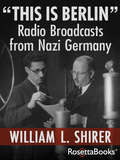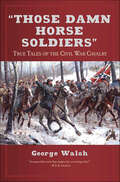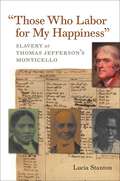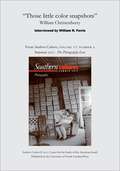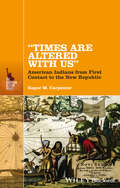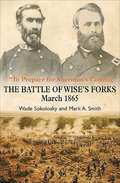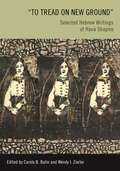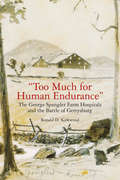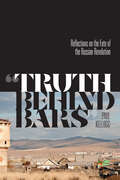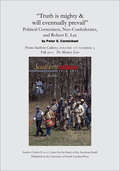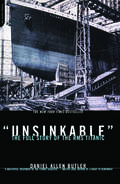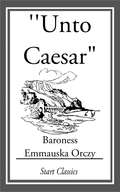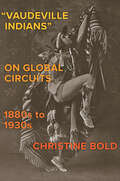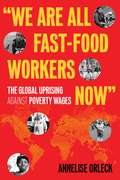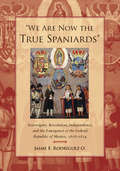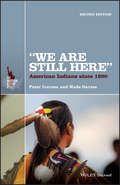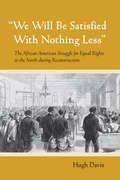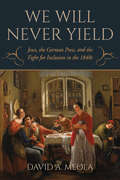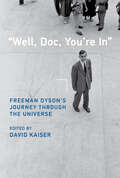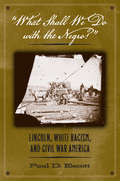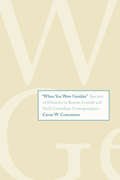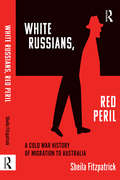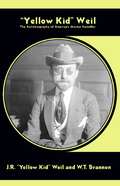- Table View
- List View
"This Is Berlin": Radio Broadcasts from Nazi Germany
by William L. ShirerThe legendary CBS news journalist&’s selection of iconic World War II radio broadcasts from countries throughout Europe. William L. Shirer was the first journalist hired by CBS to cover World War II in Europe, where he continued to work for over a decade as a news broadcaster. This book compiles two and a half years&’ worth of wartime broadcasts from Shirer&’s time on the ground during WWII. He was with Nazi forces when Hitler invaded Austria and made it a part of Germany under the Anschluss; he was also the first to report back to the United States on the armistice between France and Nazi forces in June of 1940. His daily roundup of news from Paris, Vienna, Berlin, Rome, and London, which documented Nazi Germany and the conditions of countries under invasion and at war, became famous for its gripping urgency. Shirer brought a sense of immediacy to the war for listeners in the United States and worldwide, and his later books, including the seminal Rise and Fall of the Third Reich, became definitive works on World War II history. This collection of Shirer&’s radio broadcasts offers all the original suspense and vivid storytelling of the time, bringing World War II to life for a modern audience.
"Those Damn Horse Soldiers": True Tales of the Civil War Cavalry
by George WalshThe historian and author of Whip the Rebellion shares “an excellent popular history of Civil War cavalry” from the outbreak of war to its bitter end (Booklist).Many accounts of the Civil War battles, armies, and key figures have been written over the years, but none have looked at the bloodiest war in our nation’s history through the eyes of the cavalry. The horse soldiers in the Civil War are often referred to as the last of the cavaliers, men who valued their honor as much as their cause.In this sweeping history, George Walsh brings to life anew the gallant horse soldiers of the North and South, showing in dramatic detail how their raids and expeditions affected the outcome of the war and how their fortunes waxed and waned. Walsh offers vivid portraits of cavalrymen such as Fitzhugh Lee, son of Confederate commanding general Robert E. Lee; the “Gray Ghost” John Singleton Mosby; the young and fiery George Armstrong Custer; and many others.
"Those Who Labor for My Happiness": Slavery at Thomas Jefferson's Monticello (Jeffersonian America)
by Lucia C. StantonOur perception of life at Monticello has changed dramatically over the past quarter century. The image of an estate presided over by a benevolent Thomas Jefferson has given way to a more complex view of Monticello as a working plantation, the success of which was made possible by the work of slaves. At the center of this transition has been the work of Lucia "Cinder" Stanton, recognized as the leading interpreter of Jefferson’s life as a planter and master and of the lives of his slaves and their descendants. This volume represents the first attempt to pull together Stanton’s most important writings on slavery at Monticello and beyond.Stanton’s pioneering work deepened our understanding of Jefferson without demonizing him. But perhaps even more important is the light her writings have shed on the lives of the slaves at Monticello. Her detailed reconstruction for modern readers of slaves’ lives vividly reveals their active roles in the creation of Monticello and a dynamic community previously unimagined. The essays collected here address a rich variety of topics, from family histories (including the Hemingses) to the temporary slave community at Jefferson’s White House to stories of former slaves’ lives after Monticello. Each piece is characterized by Stanton’s deep knowledge of her subject and by her determination to do justice to both Jefferson and his slaves.Published in association with the Thomas Jefferson Foundation.
"Those little color snapshots": William Christenberry
by William FerrisFollow the evolution of the vision and career of one of the South's foremost photographers."Santa Claus had brought me and my sister a small Brownie camera in the late 1940s, and I just loaded it with color film and went out to that Alabama landscape and began to photograph what caught my eye." This article appears in the Summer 2011 issue of Southern Cultures:The Photography Issue.
"Times Are Altered with Us": American Indians from First Contact to the New Republic (The American History Series)
by Roger M. Carpenter"Times Are Altered with Us": American Indians from Contact to the New Republic offers a concise and engaging introduction to the turbulent 300-year-period of the history of Native Americans and their interactions with Europeans—and then Americans—from 1492 to 1800. Considers the interactions of American Indians at many points of "First Contact" across North America, from the Gulf of Mexico to the Pacific and Atlantic Coasts Explores the early years of contact, trade, reciprocity, and colonization, from initial engagement of different Indian and European peoples—Spanish, French, Dutch, English, and Russian—up to the start of tenuous and stormy relations with the new American government Charts the rapid decline in American Indian populations due to factors including epidemic Old World diseases, genocide and warfare by explorers and colonists, tribal warfare, and the detrimental effects of resource ruination and displacement from traditional lands Features a completely up-to-date synthesis of the literature of the field Incorporates useful student features, including maps, illustrations, and a comprehensive and evaluative Bibliographical Essay Written in an engaging style by an expert in Native American history and designed for use in both the U.S. history survey as well as dedicated courses in Native American studies
"To Prepare for Sherman's Coming": The Battle of Wise's Forks, March 1865
by Mark A. Smith Wade SokoloskyThe Battle of Wises (Wyse) Forks, March 7-11, 1865, has long been thought of as nothing more than an insignificant skirmish during the final days of the Civil War and relegated to a passing reference in a footnote if it is mentioned at all. Mark A. Smiths and Wade Sokoloskys To Prepare for Shermans Coming: The Battle of Wises Forks, March 1865 erases this misconception and elevates this combat and its related operations to the historical status it deserves.By March 1865, the Confederacy was on its last legs. Its armies were depleted, food and resources were scarce, and morale was low. General Lee was barely holding on to his extended lines around Richmond and Petersburg, and Gen. William T. Sherman was operating with nearly complete freedom in North Carolina on his way north to form a junction with Union forces in Virginia. As the authors demonstrate, the fighting that is the subject of this book came about when Lt. Gen. Ulysses S. Grant initiated a broad military operation to assist Sherman.The responsibility for ensuring a functioning railroad from New Bern to Goldsboro rested with Maj. Gen. Jacob D. Cox. On March 2, 1865, Cox ordered his hastily assembled Provisional Corps to march toward Goldsboro. In response to Coxs movement, Confederate Gen. Joseph E. Johnston executed a bold but risky plan to divert troops away from Sherman by turning back Coxs advance. Under the command of the aggressive but controversial Gen. Braxton Bragg, the Confederates stood for four days and successfully halted Cox at Wises Forks. This delay provided Johnston with the precious time he needed to concentrate his forces and fight the large and important Battle of Bentonville.To Prepare for Shermans Coming is the result of years of careful research in a wide variety of archival sources, and relies upon official reports, diaries, newspapers, and letter collections, all tied to a keen understanding of the terrain. Sokolosky and Smith, both career army officers, have used their expertise in military affairs to produce what is not only a valuable book on Wises Forks, but what surely must be the definitive study of one of the Civil Wars overlooked yet significant battles. Outstanding original maps by Mark A. Moore coupled with period photographs reinforce the quality of this account and the authors commitment to excellence.
"To Tread on New Ground": Selected Hebrew Writings of Hava Shapiro
by Carole B. Balin Wendy I. ZierlerHava Shapiro is among the nearly forgotten Jewish women writers who sought acceptance in Jewish literary circles of the last century. Born in Slavuta (modern-day Ukraine) in 1878, she published works of fiction, memoir, literary criticism, and journalism, including a volume of short fiction and a scholarly monograph on the Czech leader Masaryk. Her handwritten diary--the first known diary to be kept by a woman in Hebrew--evokes not only the momentous events of her day but also the experiences of women like herself who failed to follow the dictates of Jewish tradition and aspired to roles beyond those of wife and mother. In "To Tread New Ground": Selected Writings of Hava Shapiro, editors and translators Carole B. Balin and Wendy I. Zierler present an English anthology of Shapiro's late-nineteenth- and early-twentieth-century Hebrew writings. The selection culls from her short fiction, feminist literary criticism, reportage and literary essays, as well as her diary and hundreds of letters. Shapiro chronicled, publicly and privately, such cataclysmic events as the Russian Revolution and both World Wars in addition to critical episodes in the Jewish past, including pogroms, mass migration, ruptures in traditional Jewish life, and the development of Zionism. A list of Shapiro's intimates, whom she describes in both her diary and published reminiscences, reads like a "who's who" of the Russian Haskalah, including Y. L. Peretz, Reuven Brainin, David Frischmann, Nahum Sokolov, Micha Yosef Berdischevsky, and Hayim Nahman Bialik. To further contextualize Shapiro's writings, Balin and Zierler include a thorough introduction and translations of critical essays about Shapiro. Balin and Zierler's Hebrew edition of Shapiro's writing, Behikansi atah, which was published in Israel in 2008, brought the first broad attention and readership to Shapiro's remarkable biography and writings. The translations in "To Tread New Ground," which include previously uncollected materials, will be welcomed by English-speaking readers interested in Hebrew literature, East European Jewish history, and gender studies.
"Too Much for Human Endurance": The George Spangler Farm Hospitals and the Battle of Gettysburg
by Ronald D. KirkwoodThe bloodstains are gone, but the worn floorboards remain. The doctors, nurses, and patients who toiled and suffered and ached for home at the Army of the Potomac’s XI Corps hospital at the George Spangler Farm in Gettysburg have long since departed. Happily, though, their stories remain, and noted journalist and George Spangler Farm expert Ronald D. Kirkwood brings these people and their experiences to life in “Too Much for Human Endurance”: The George Spangler Farm Hospitals and the Battle of Gettysburg. Using a massive array of firsthand accounts, Kirkwood re-creates the sprawling XI Corps hospital complex and the people who labored and suffered there—especially George and Elizabeth Spangler and their four children, who built a thriving 166-acre farm only to witness it nearly destroyed when war paid them a bloody visit that summer of 1863. Stories rarely if ever told of nurses, surgeons, ambulance workers, musicians, teenage fighters, and others are weaved seamlessly through gripping, smooth-flowing prose. A host of notables spent time at the Spangler farm, including Union officers George G. Meade, Henry J. Hunt, Edward E. Cross, Francis Barlow, Francis Mahler, Freeman McGilvery, and Samuel K. Zook. Pvt. George Nixon III, great-grandfather of President Richard M. Nixon, would die there, as would Confederate Gen. Lewis A. Armistead, who fell mortally wounded at the height of Pickett’s Charge. In addition to including the most complete lists ever published of the dead, wounded, and surgeons at the Spanglers’ XI Corps hospital, this study breaks new ground with stories of the First Division, II Corps hospital at the Spanglers’ Granite Schoolhouse. Kirkwood also establishes the often-overlooked strategic importance of the property and its key role in the Union victory. Army of the Potomac generals took advantage of the farm’s size, access to roads, and central location to use it as a staging area to get artillery and infantry to the embattled front line from Little Round Top north to Cemetery Hill just in time to prevent its collapse and a Confederate breakthrough. “Too Much for Human Endurance”: The George Spangler Farm Hospitals and the Battle of Gettysburg introduces readers to heretofore untold stories of the Spanglers, their farm, those who labored to save lives and those who suffered and died there. They have finally received the recognition their place in history deserves.
"Truth Behind Bars": Reflections on the Fate of the Russian Revolution
by Paul KelloggJust north of the Arctic Circle is the settlement of Vorkuta, a notorious camp in the Gulag internment system that witnessed three pivotal moments in Russian history. In the 1930s, a desperate hunger strike by socialist prisoners, victims of Joseph Stalin’s repressive regime, resulted in mass executions. In 1953, a strike by forced labourers sounded the death knell for the Stalinist forced labour system. And finally, in the late 1980s and early 1990s, a series of strikes by new, independent miners’ unions were central to overturning the Stalinist system. Paul Kellogg uses the story of Vorkuta as a frame with which to re-assess the Russian Revolution. In particular, he turns to the contributions of Iulii Martov, a contemporary of Lenin, and his analysis of the central role played in the revolution by a temporary class of peasants-in-uniform. Kellogg explores the persistence and creativity of workers’ resistance in even the darkest hours of authoritarian repression and offers new perspectives on the failure of democratic governance after the Russian Revolution.
"Truth is mighty & will eventually prevail": Political Correctness, Neo-Confederates, and Robert E. Lee
by Peter S. CarmichaelTruth is mighty & will eventually prevail" Political Correctness, Neo-Confederates, and Robert E. Leeby Peter S. CarmichaelWhy do we argue—and argue—so much about Robert E. Lee?"While northerners might appear comparatively apathetic about the memory of the Union cause, white southerners have been tenacious in searching for moral clarity in the past."
"Unsinkable": The Full Story of RMS Titanic
by Daniel Allen ButlerThis passionate yet balanced narrative explores every facet of the Titanic's history, including her spectacular conception in an Irish shipyard and the ambitious modern-day attempts to salvage her. The familiar story of the RMS Titanic-from her encounter with an iceberg to her demise some three hours later, taking with her more than fifteen hundred people-still looms large in the popular imagination, and in Daniel Butler's as well. He studied the Titanic's history for thirty years, intensively compiling facts about the disaster and the players involved (from Captain Smith and his crew to the ill-fated third-class passengers). He even made the startling discovery of a nearby ship that ignored the Titanic's distress call because the shipmates were afraid to awaken their captain. Drawn from primary sources and period accounts, this new narrative puts the disaster into historical context and serves as an essential resource for scholars of Titanic lore.
"Unto Caesar"
by Emmauska OrczyBaroness Emma Magdolna Rozália Mária Jozefa Borbála "Emmuska" Orczy de Orczi (23 September 1865 - 12 November 1947) was a Hungarian-born British novelist, playwright and artist of noble origin. She is most known for her series of novels featuring the Scarlet Pimpernel. This is one of her novels.
"Vaudeville Indians" on Global Circuits, 1880s-1930s (The Henry Roe Cloud Series on American Indians and Modernity)
by Christine BoldUncovering hidden histories of Indigenous performers in vaudeville and in the creation of western modernity and popular culture Drawing from little-known archives, Christine Bold brings to light forgotten histories of Indigenous performers in vaudeville and, by extension, popular culture and modernity. Vaudeville was both a forerunner of modern mass entertainment and a rich site of popular Indigenous performance and notions of Indianness at the turn of the twentieth century. Tracing the stories of artists Native to Turtle Island (North America) performing across the continent and around the world, Bold illustrates a network of more than 300 Indigenous and Indigenous-identifying entertainers, from Will Rogers to Go-won-go Mohawk to Princess Chinquilla, who upend vaudeville&’s received history. These fascinating stories cumulatively reveal vaudeville as a space in which the making of western modernity both denied and relied on living Indigenous presence, and in which Indigenous artists negotiated agency and stereotypes through vaudeville performance.
"Watch Out for the Foreign Guests!"
by Orville SchellThis vivid, prophetic book on China's magnetic attraction to the West is the perfect introduction to China in the eighties.
"We Are All Fast-Food Workers Now": The Global Uprising Against Poverty Wages
by Annelise OrleckThe story of low-wage workers rising up around the world to demand respect and a living wage.Tracing a new labor movement sparked and sustained by low-wage workers from across the globe, "We Are All Fast-Food Workers Now" is an urgent, illuminating look at globalization as seen through the eyes of workers-activists: small farmers, fast-food servers, retail workers, hotel housekeepers, home-healthcare aides, airport workers, and adjunct professors who are fighting for respect, safety, and a living wage. With original photographs by Liz Cooke and drawing on interviews with activists in many US cities and countries around the world, including Bangladesh, Cambodia, Mexico, South Africa, and the Philippines, it features stories of resistance and rebellion, as well as reflections on hope and change as it rises from the bottom up.
"We Are Now the True Spaniards": Sovereignty, Revolution, Independence, and the Emergence of the Federal Republic of Mexico, 1808-1824
by Jaime E. Rodríguez O.This book is a radical reinterpretation of the process that led to Mexican independence in 1821—one that emphasizes Mexico's continuity with Spanish political culture. During its final decades under Spanish rule, New Spain was the most populous, richest, and most developed part of the worldwide Spanish Monarchy, and most novohispanos (people of New Spain) believed that their religious, social, economic, and political ties to the Monarchy made union preferable to separation. Neither the American nor the French Revolution convinced the novohispanos to sever ties with the Spanish Monarchy; nor did the Hidalgo Revolt of September 1810 and subsequent insurgencies cause Mexican independence. It was Napoleon's invasion of Spain in 1808 that led to the Hispanic Constitution of 1812. When the government in Spain rejected those new constituted arrangements, Mexico declared independence. The Mexican Constitution of 1824 affirms both the new state's independence and its continuance of Spanish political culture.
"We Are Still Here": American Indians Since 1890 (The American History Series #51)
by Peter Iverson Wade DaviesIn addition to revisions and updates, the second edition of “We Are Still Here” features new material, seeing this well-loved American History Series volume maintain its treatment of American Indians in the 20th century while extending its coverage into the opening decades of the 21st century. Provides student and general readers concise and engaging coverage of contemporary history of American Indians contributed by top scholars and instructors in the field Represents an ideal supplement to any U.S. or Native American survey text Includes a completely up-to-date synthesis of the most current literature in the field Features a comprehensive Bibliographical Essay that serves to aid student research and writing Covers American Indian history from 1890 through 2013
"We Will Be Satisfied With Nothing Less": The African American Struggle for Equal Rights in the North during Reconstruction
by Hugh DavisHistorians have focused almost entirely on the attempt by southern African Americans to attain equal rights during Reconstruction. However, the northern states also witnessed a significant period of struggle during these years. Northern blacks vigorously protested laws establishing inequality in education, public accommodations, and political life and challenged the Republican Party to live up to its stated ideals. In "We Will Be Satisfied With Nothing Less," Hugh Davis concentrates on the two issues that African Americans in the North considered most essential: black male suffrage rights and equal access to the public schools. Davis connects the local and the national; he joins the specifics of campaigns in places such as Cincinnati, Detroit, and San Francisco with the work of the National Equal Rights League and its successor, the National Executive Committee of Colored Persons. The narrative moves forward from their launching of the equal rights movement in 1864 to the "end" of Reconstruction in the North two decades later. The struggle to gain male suffrage rights was the centerpiece of the movement’s agenda in the 1860s, while the school issue remained a major objective throughout the period. Following the ratification of the Fifteenth Amendment in 1870, northern blacks devoted considerable attention to assessing their place within the Republican Party and determining how they could most effectively employ the franchise to protect the rights of all citizens.
"We Will Never Yield": Jews, the German Press, and the Fight for Inclusion in the 1840s (German Jewish Cultures)
by David A. MeolaHow did German Jews present their claims for equality to everyday Germans in the first half of the nineteenth century? We Will Never Yield offers the first English-language study of the role of the German press in the fight for Jewish agency and participation during the 1840s. David Meola explores how the German press became a key venue for public debates over Jewish emancipation; religious, educational, and occupational reforms; and the role of Jews in German civil society, even against a background of escalating violence against the Jews in Germany. We Will Never Yield sheds light on the struggle for equality by German Jews in the 1840s and demonstrates the value of this type of archival source of Jewish voices that has been previously underappreciated by historians of Jewish history.
"Well, Doc, You're In": Freeman Dyson’s Journey through the Universe
by Edited by David KaiserThe life and work of Freeman Dyson—renowned scientist, visionary, and iconoclast—and his particular way of thinking about deep questions.Freeman Dyson (1923–2020)—renowned scientist, visionary, and iconoclast—helped invent modern physics. Not bound by disciplinary divisions, he went on to explore foundational topics in mathematics, astrophysics, and the origin of life. General readers were introduced to Dyson&’s roving mind and heterodox approach in his 1979 book Disturbing the Universe, a poignant autobiographical reflection on life and science. &“Well, Doc, You&’re In&” (the title quotes Richard Feynman&’s remark to Dyson at a physics conference) offers a fresh examination of Dyson&’s life and work, exploring his particular way of thinking about deep questions that range from the nature of matter to the ultimate fate of the universe. The chapters—written by leading scientists, historians, and science journalists, including some of Dyson&’s colleagues—trace Dyson&’s formative years, his budding interests and curiosities, and his wide-ranging work across the natural sciences, technology, and public policy. They describe Dyson&’s innovations at the intersection of quantum theory and relativity, his novel nuclear reactor design (and his never-realized idea of a spacecraft powered by nuclear weapons), his years at the Institute for Advanced Study, and his foray into cosmology. In the coda, Dyson&’s daughter Esther reflects on growing up in the Dyson household. &“Well, Doc, You&’re In&” assesses Dyson&’s successes, blind spots, and influence, assembling a portrait of a scientist&’s outsized legacy. ContributorsJeremy Bernstein, Robbert Dijkgraaf, Esther Dyson, George Dyson, Ann Finkbeiner, Amanda Gefter, Ashutosh Jogalekar, David Kaiser, Caleb Scharf, William Thomas
"What Shall We Do with the Negro?": Lincoln, White Racism, and Civil War America
by Paul D. EscottThroughout the Civil War, newspaper headlines and stories repeatedly asked some variation of the question posed by the New York Times in 1862, "What shall we do with the negro?" The future status of African Americans was a pressing issue for those in both the North and in the South. Consulting a broad range of contemporary newspapers, magazines, books, army records, government documents, publications of citizens' organizations, letters, diaries, and other sources, Paul D. Escott examines the attitudes and actions of Northerners and Southerners regarding the future of African Americans after the end of slavery. "What Shall We Do with the Negro?" demonstrates how historians together with our larger national popular culture have wrenched the history of this period from its context in order to portray key figures as heroes or exemplars of national virtue. Escott gives especial critical attention to Abraham Lincoln. Since the civil rights movement, many popular books have treated Lincoln as an icon, a mythical leader with thoroughly modern views on all aspects of race. But, focusing on Lincoln's policies rather than attempting to divine Lincoln's intentions from his often ambiguous or cryptic statements, Escott reveals a president who placed a higher priority on reunion than on emancipation, who showed an enduring respect for states' rights, who assumed that the social status of African Americans would change very slowly in freedom, and who offered major incentives to white Southerners at the expense of the interests of blacks.Escott's approach reveals the depth of slavery's influence on society and the pervasiveness of assumptions of white supremacy. "What Shall We Do with the Negro?" serves as a corrective in offering a more realistic, more nuanced, and less celebratory approach to understanding this crucial period in American history.
"When You Were Gentiles"
by Cavan W ConcannonCavan W. Concannon makes a significant contribution to Pauline studies by imagining the responses of the Corinthians to Paul's letters. Based on surviving written materials and archaeological research, this book offers a textured portrait of the ancient Corinthians with whom Paul conversed, argued, debated, and partnered, focusing on issues of ethnicity, civic identity, politics, and empire. In doing so, the author provides readers a unique opportunity to assess anew, and imagine possibilities beyond, Paul's complicated legacy in shaping Western notions of race, ethnicity, and religion.
"White Russians, Red Peril": A Cold War History of Migration to Australia
by Sheila FitzpatrickOver 20,000 ethnic Russians migrated to Australia after World War II – yet we know very little about their experiences. Some came via China, others from refugee camps in Europe. Many preferred to keep a low profile in Australia, and some attempted to ‘pass’ as Polish, West Ukrainian or Yugoslavian. They had good reason to do so: to the Soviet Union, Australia’s resettling of Russians amounted to the theft of its citizens, and undercover agents were deployed to persuade them to repatriate. Australia regarded the newcomers with wary suspicion, even as it sought to build its population by opening its door to more immigrants. Making extensive use of newly discovered Russian-language archives and drawing on a lifetime’s study of Soviet history and politics, award-winning author Sheila Fitzpatrick examines the early years of a diverse and disunited Russian-Australian community and how Australian and Soviet intelligence agencies attempted to track and influence them. While anti-Communist ‘White’ Russians dreamed a war of liberation would overthrow the Soviet regime, a dissident minority admired its achievements and thought of returning home.
"Yellow Kid" Weil
by J. R. Weil Bruno Ruhland W. T. BrannonBilked bankers, grifted gamblers, and swindled spinsters: welcome to the world of confidence men.You'll marvel at the elaborate schemes developed by The Yellow Kid and cry for the marks who lost it all to his ingenuity-$8,000,000 by some estimations. Fixed horse races, bad real-estate deals, even a money-making machine-all were tools of the trade for the Kid and his associates: the Swede, the Butterine Kid, the Harmony Kid, Fats Levine, and others. The Sting (1973), starring Paul Newman and based largely on the story of the Yellow Kid, is entertaining, but is no match for the real deal.
"You Ain't Heard Nothin' Yet": The American Talking Film, History and Memory, 1927-1949 1st Edition
by Andrew SarrisAndrew Sarris has long been one of America's most celebrated writers on film, author of the pioneering work "The American Cinema," and for decades a highly regarded critic. Now comes Sarris's definitive statement on film, in a masterwork that has taken twenty-five years to complete. Here is a sweeping--and highly personal--history of American film, from the birth of the talkies (beginning with "The Jazz Singer "and Al Jolson's memorable line "You ain't heard nothin' yet") to the decline of the studio system. By far the largest section of the book celebrates the great American film directors, with the work of giants such as John Ford, Alfred Hitchcock, Charlie Chaplin, Orson Welles, and Howard Hawks examined film by film. Sarris also offers glowing portraits of major stars, from Garbo and Bogart to Ingrid Bergman, Margaret Sullavan, Spencer Tracy, Katharine Hepburn, Clark Gable, and Carole Lombard. There is a tour of the studios--Metro, Paramount, RKO, Warner Brothers, 20th Century-Fox, Universal--revealing how each left its own particular stamp on film. And in perhaps the most interesting and original section, we are treated to an informative look at film genres--the musical, the screwball comedy, the horror picture, the gangster film, and the western. A lifetime of watching and thinking about cinema has gone into this book. It is the history that film buffs have been waiting for.
